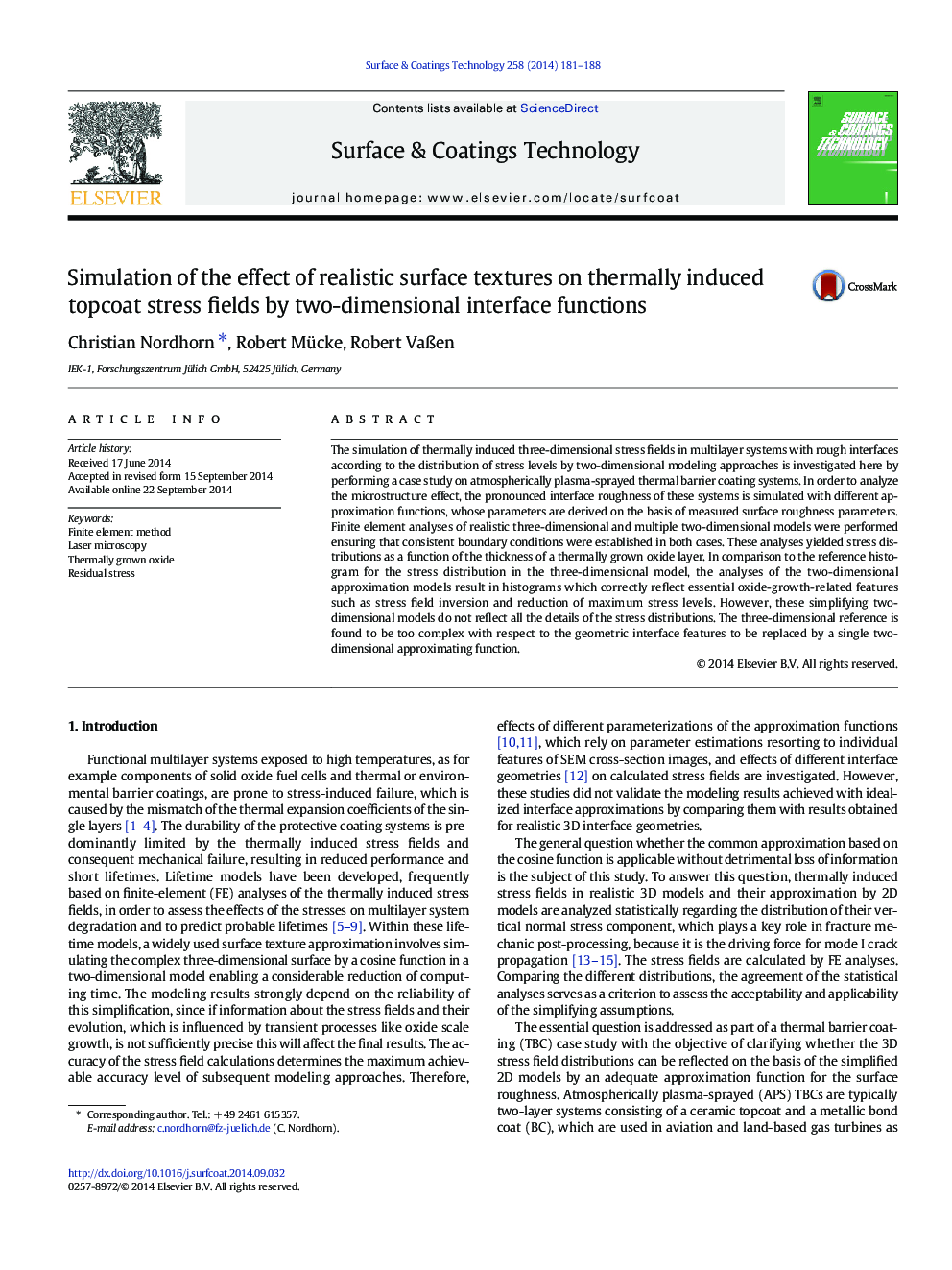| کد مقاله | کد نشریه | سال انتشار | مقاله انگلیسی | نسخه تمام متن |
|---|---|---|---|---|
| 8027209 | 1517620 | 2014 | 8 صفحه PDF | دانلود رایگان |
عنوان انگلیسی مقاله ISI
Simulation of the effect of realistic surface textures on thermally induced topcoat stress fields by two-dimensional interface functions
ترجمه فارسی عنوان
شبیه سازی اثر بافت سطحی واقع گرایانه بر زمینه های استرس پوسته گرمائی توسط توابع رابط دو بعدی
دانلود مقاله + سفارش ترجمه
دانلود مقاله ISI انگلیسی
رایگان برای ایرانیان
کلمات کلیدی
روش عنصر محدود میکروسکوپ لیزری، اکسید رشد شده به صورت حرارتی، استرس باقی مانده،
ترجمه چکیده
شبیه سازی رشته های استرس سه بعدی با گرمازا در سیستم های چند لایه با رابط های خشن با توجه به توزیع سطوح استرس با رویکرد مدل سازی دو بعدی در اینجا با انجام یک مطالعه موردی بر روی سیستم های پوشش محافظ حرارتی پاشش پلاسما به صورت جیوه مورد بررسی قرار می گیرد. برای تجزیه و تحلیل اثر ریزساختار، شفافیت رابط گرافیکی این سیستم ها با توابع تقریبی مختلف، که پارامترهای آن بر اساس پارامترهای زبری سطح اندازه گیری شده است، شبیه سازی شده است. تجزیه و تحلیل عناصر محدود از مدل های واقعی سه بعدی و چند بعدی دو بعدی انجام شده و اطمینان حاصل شد که شرایط مرزی سازگار در هر دو مورد ایجاد شده است. این تجزیه و تحلیل ها توزیع تنش را به عنوان یک تابع از ضخامت یک لایه اکسید گرما افزایش داده است. در مقایسه با هیستوگرام مرجع برای توزیع تنش در مدل سه بعدی، تجزیه و تحلیل مدل های تقریبی دو بعدی منجر به هیستوگرام هایی می شود که به درستی نشان دهنده ویژگی های مرتبط با رشد اکسید ضروری مانند چرخش استرس و کاهش حداکثر سطوح استرس . با این حال، این مدلهای ساده دو بعدی تمام جزئیات توزیع تنش را منعکس نمی کند. مرجع سه بعدی، با توجه به ویژگی های رابط هندسی که با یک تابع تقریبی دو بعدی تکمیل می شود، بسیار پیچیده است.
موضوعات مرتبط
مهندسی و علوم پایه
مهندسی مواد
فناوری نانو (نانو تکنولوژی)
چکیده انگلیسی
The simulation of thermally induced three-dimensional stress fields in multilayer systems with rough interfaces according to the distribution of stress levels by two-dimensional modeling approaches is investigated here by performing a case study on atmospherically plasma-sprayed thermal barrier coating systems. In order to analyze the microstructure effect, the pronounced interface roughness of these systems is simulated with different approximation functions, whose parameters are derived on the basis of measured surface roughness parameters. Finite element analyses of realistic three-dimensional and multiple two-dimensional models were performed ensuring that consistent boundary conditions were established in both cases. These analyses yielded stress distributions as a function of the thickness of a thermally grown oxide layer. In comparison to the reference histogram for the stress distribution in the three-dimensional model, the analyses of the two-dimensional approximation models result in histograms which correctly reflect essential oxide-growth-related features such as stress field inversion and reduction of maximum stress levels. However, these simplifying two-dimensional models do not reflect all the details of the stress distributions. The three-dimensional reference is found to be too complex with respect to the geometric interface features to be replaced by a single two-dimensional approximating function.
ناشر
Database: Elsevier - ScienceDirect (ساینس دایرکت)
Journal: Surface and Coatings Technology - Volume 258, 15 November 2014, Pages 181-188
Journal: Surface and Coatings Technology - Volume 258, 15 November 2014, Pages 181-188
نویسندگان
Christian Nordhorn, Robert Mücke, Robert VaÃen,
